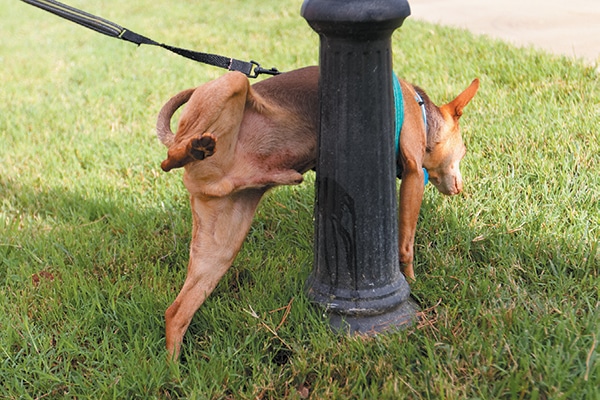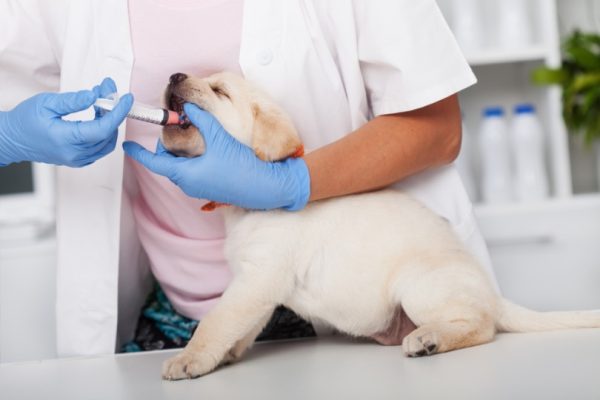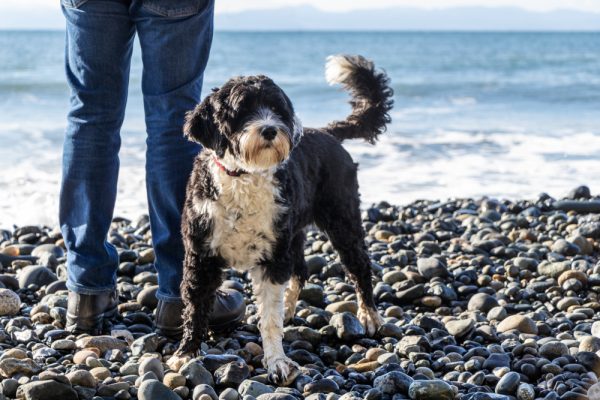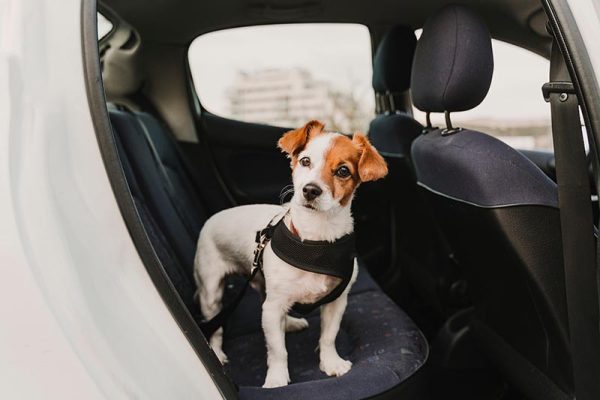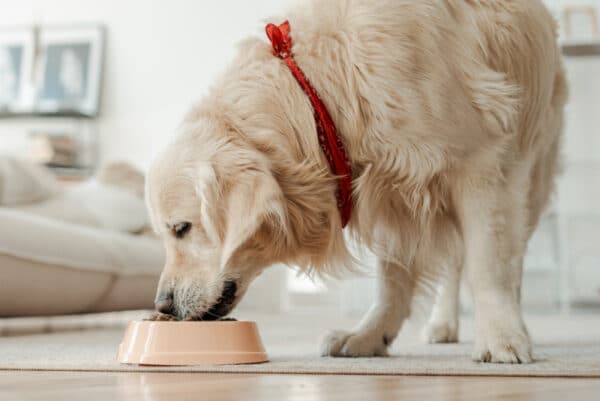When you walk your dog, do they want to stop and pee on every post, patch of grass, and plant along the way? Has your dog peed on something in the house? If you’re nodding your head right about now, congratulations! You have a marker. But don’t worry, we’re here to help.

What is marking and why do dogs do it?
First, make sure any peeing in the house isn’t a house training or medical issue. Once you’ve ruled that out, you can assume that your dog is marking.
Marking is when your dog pees on something, even when they don’t really have to go to the bathroom. Usually, marking involves a much smaller amount of pee than when your dog actually has to go. Have you seen your dog squat or lift a leg, and only a couple drops have come out? That’s marking.
Dogs of either sex engage in this behavior, and while it is a territorial behavior, it has nothing to do with the outdated concept of dominance. One of the primary ways that dogs communicate with each other is through smell (hence sniffing each other when they first meet, and sniffing constantly during walks — they are gathering information). Marking lets other dogs know that they are there, and maybe even that they are available for mating. When another dog pees in your front yard, for example, your dog will pee on top of it, as if to say “hello, but this is my yard.”
You may think that this sounds like one dog establishing dominance over the others in the neighborhood. But territorial behavior is more about social hierarchy than dominance. Social hierarchy with dogs is fluid, which is why one dog may let another eat out of his bowl while he stands and watches, but that same dog would growl if someone came near his toy or bed. Territorial marking is more like saying, “this space is already claimed, so you need to go somewhere else.” In the wild, animals typically respect each other’s boundaries and the social hierarchy without conflict (except prey/predator relationships, of course), and that’s one wild animal behavior that our domestic dogs still exhibit.
And just as marking is not related to dominance, it is also not done out of jealousy. If a new person or baby comes into your home and your dog pees on their bag, it’s not because your dog hates them or wants to “show them who’s boss.” It’s much more likely that the unfamiliar scent stresses your dog out, or there is another dog scent on the bag and your dog wants to claim the bag as theirs since it’s in “their” house.
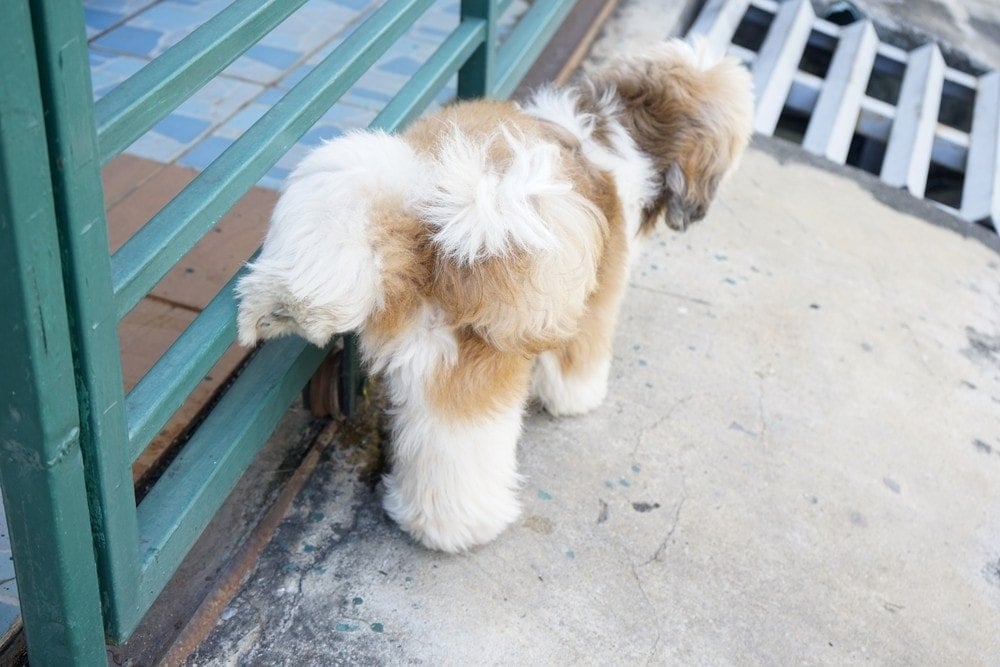
How to eliminate marking
Neutering or spaying your dog will greatly reduce marking. If your dog gets fixed later in life — say you rescue a pup who has lived on the streets — it is more of a learned behavior and will likely continue after the surgery (though it shouldn’t happen as often).
If your dog only marks while you’re walking, choose a cue like “let’s go” or “not now,” and keep walking when they try to pee on everything. It also can be helpful to teach them a cue for when it’s time to go to the bathroom, or when they are allowed to sniff and pee freely, like “go sniff” or “go potty.” Your dog can learn when it is and is not appropriate to stop when you are walking (this is also super helpful if you run with your dog).
If your dog marks in the house, supervision is important (just like if you were house training a puppy). If you see your dog squat or lift a leg, call their name or otherwise get their attention. You don’t need to yell or shake a can of pennies — your dog isn’t doing anything wrong by their standards. Marking is a natural behavior. And, in fact, if your dog is marking due to fear or anxiety, this may make the issue worse. Distracting or redirecting your dog is an easy and low-stress way to stop it. If you think anxiety is behind your dog’s marking behavior, ask your vet for support to help reduce your dog’s anxiety, from pheromone diffusers to supplements, or even medication that may help curb the behavior.
The umbilical cord method consists of tying your dog’s leash to your pants to ensure you monitor their behavior during the day and bring them out if they seem to want to urinate. If you can’t supervise your dog, they should be in a crate. Make it a happy, comfortable experience, and your dog won’t mind one bit.
It’s also really important to completely clean up any spots where your dog (or another dog) has already peed. Use an enzymatic cleaner specifically for removing urine to make sure any trace of it is gone.
You can also manage the issue by being proactive and keeping guests’ belongings up and out of reach. If your dog can’t reach it, they can’t pee on it.
Our Favorite Cleaner
Hepper Advanced Bio-Enzyme Pet Stain & Odor Eliminator Spray is our favorite all-purpose cleaner for pet messes. It permanently lifts the very worst stains and odors, making clean-up and accident prevention a breeze. Hepper offers a 100% guarantee, which is a great bonus! Learn more about it here.
| Rating | Image | Product | Details | |
|---|---|---|---|---|
| Best Enzymatic Cleaner |

|
Hepper Advanced Bio-Enzyme Pet Stain & Odor Eliminator Spray |
|
Check Price |
At Dogster, we’ve admired Hepper for many years, and decided to take a controlling ownership interest so that we could benefit from the outstanding products of this cool pet company!


As always, get help if you need it
Sometimes dogs mark when you get a new pet because there is a new animal in their territory/home. If this is the case, you may want to get a positive reinforcement trainer involved. A veterinarian or trainer can help your pets to co-exist and help you create a calmer household.
If you need to speak with a vet but can't get to one, head over to PangoVet. It's an online service where you can talk to a vet online and get the personalized advice you need for your pet — all at an affordable price!

Featured Image Credit: Harrison Waters, Shutterstock

